A look at in-built lights and e-bike compatible lights versus conventional standalone bike lights
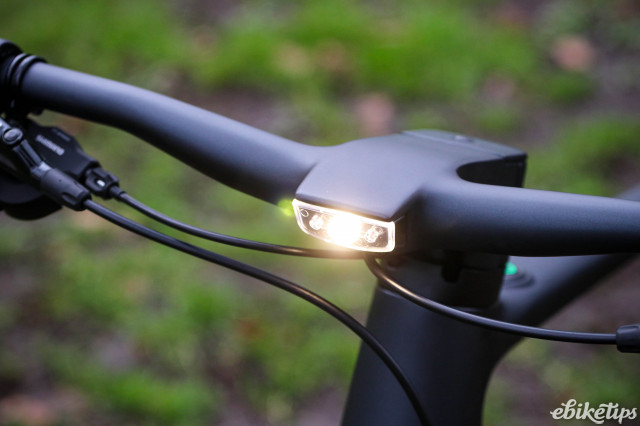
Many e-bikes come with LED lights ‘hardwired’ in – that is to say they run from the bike’s main battery. So as long as you have some battery capacity left, you should have lights. But not every e-bike has lights and even if yours does, there are several reasons why you might still be in the market for some more.
There are still plenty of e-bikes that come without lights: e-MTBs and conversion kits are the two most common e-bike types where this is likely to be the case. Equally, you may want to upgrade the power of your lights – and the front light especially – if you find that you don’t have enough illumination to ride on roads and tracks without street lighting.
You may want a set of backup lights in case your main ones fail (or perhaps they have already failed and you need replacements), or you want to take advantage of the latest lighting tech. Front lights with super power but cleverly focused beams that don’t blind oncoming road users and rear lights that double as brake lights are just two examples.
You’ll need to decide firstly whether to opt for hardwired or independently-powered lights on your e-bike (it’s not always possible to fit hardwired lights) and secondly how much lightling power and what other features you need.
So let’s take a more detailed look at the options for adding lighting to your e-bike.
Hardwired vs independently-powered – what are your options?
Hardwired
As long as your battery has enough capacity for your requirements, powering lights from the e-bike’s battery is a great option. You are never likely to run out of battery power for your lights. (Some e-bikes’ lights will remain powered even if there is not enough capacity for the motor as the system will keep a small amount of power in reserve.)
Don’t hardwired lights take a big chunk out of your range? The large majority of hardwired lights take anything from a pretty small to a tiny fraction of the power used from the main bike battery. This is largely because of the revolution bought about by LED lights which use a fraction of the power of older bulb technologies.
E-bike motors commonly produce 250W of power and can peak at several times this for short periods. E-bike LED lights require anything from around 2W to 25W (and that’s front and rear combined). This is unlikely to make much of a difference to your range unless you spend many hours riding around in the dark with hugely powerful lights on.
The main drawback of independently-powered lights is of course that they run out of battery power and it’s not always easy to tell when this will happen (though some of the better ones have a state of charge indicator). Probably the main reason for choosing them would be if it’s simply not possible to connect hardwired lights to your e-bike.
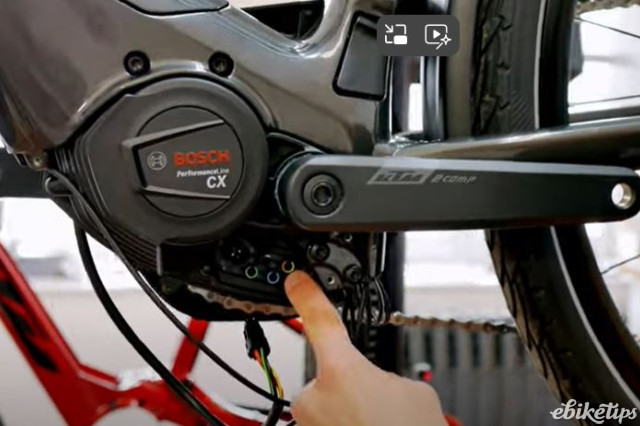
Most e-bikes with quality motor systems – even if they aren’t already fitted with lights – feature a port lighting can be plugged into and there are often conduits within the frame to keep things neat and tidy. The problem is that you need a light that is compatible with the power supply voltage and the type of connector, as there is no common agreed standard. This table of compatability for some of Lezyne’s lights shows the complexity of the situation.
If you are struggling to locate the light connector on your e-bike and simply want an upgrade, a shortcut method is to simply snip off the wires on the old light then solder and shrinkwrap the new light on. However, you MUST make sure the new light is voltage compatible with the supply. If it’s rated more than the supply, it won’t light up and if it’s rated a lot less it may blow or overheat quickly.
You may see YouTube videos and the like showing you how to step down your e-bike battery voltage to 12V with a DC-DC converter (many older tech lights traditionally run on 12V only) but as this is one more part to accommodate and they aren’t necessarily waterproof, it’s not a method I would recommend.

The ‘snip and solder’ approach is likely to be more acceptable to users on budget e-bikes and it has been helped by the fact that modern retrofittable lights are now increasingly made with inbuilt DC-DC converters and so will take a range of power source voltages – check out these high quality Busch & Muller lights which would be a great upgrade to cheap and cheerful lights. The priciest models have a voltage range of 6-60V that should run directly off any e-bike power source out there.
It’s worth emphasising the above upgrade method is likely to leave you open to the e-bike retailer arguing you have negated the warranty if there are problems down the line (even if they’re not necessarily to do with the lights). If that’s a worry, you could of course ask the retailer themselves if it is possible for them to upgrade your lights for you.
Independently-powered
Despite the fact the run time of independently-powered lights is limited before a recharge or replacement batteries are needed, they have come on leaps and bounds with the advent of LED technology.
Watt for watt, LEDs produce much more light and have longer run times than older bulb technologies. Also note a rear light’s battery lasts longer than a front light’s as red LED technology requires less power to work at an acceptable brightness. This means modern rear lights can be extremely light as they require minimal battery power, meaning one powered by old-school AAs or a coin battery can be very effective and cheap to buy.

Independently-powered lights still have many potential uses on e-bikes, despite the strengths of hardwired lights. They are a good option if you are simply unable to fit a hardwired light of course, but they can also act as secondary backup lights or may provide more effective lighting if your hardwired e-bike lights are just not up to the job. Do note though, you should be a bit careful with lights that have high power settings, as some of these are only good enough for an hour or two run time at the highest settings. However, at lower settings they may still be very effective and power consumption can be many times less, extending run time significantly.
As well as the power of the light itself (see below for the rather confusing mix of rating systems used) you may want to consider ease of mounting (if you want to use it on several bikes for instance), battery size and, as discussed, run times.
In general, most decent quality lights come with inbuilt and non-removable lithium-ion batteries rechargeable via a USB port – a USB C should be preferred as it is the current standard and means faster charging than older standards. This means you can charge from batteries or range extenders that have a USB charging feature (for example, the Brompton Electric main battery and the Tenways Powerbank range extender feature USB charge ports).
Whilst a built-in light battery is a convenient and quick option, it also means inbuilt obselesence, even though decent lights should last several years.
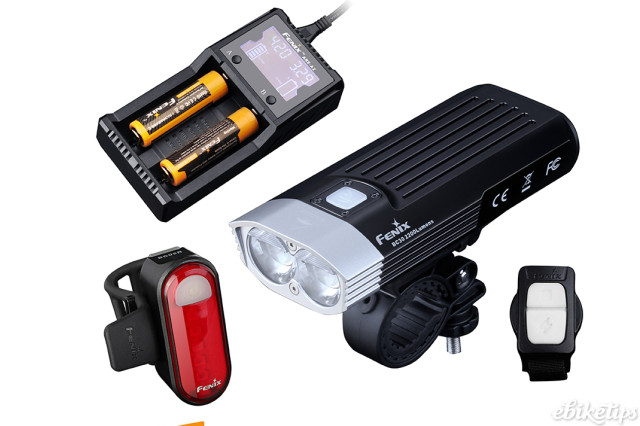
A more sustainable approach comes from Fenix whose model powered by removable 18650 lithium ion batteries allows replacement when they’re worn out. It also means you can take spare batteries with you on longer rides and swap them out if needed.
For a rundown of the latest independently-powered front lights, see the front light guide on our sister site road.cc There’s even a Cycliq model in there which doubles as an action cam and a Magicshine model that can double as a powerbank. For the best rear lights check out the road.cc list (again with an integrated camera option).
E-bike conversion kits with lighting options
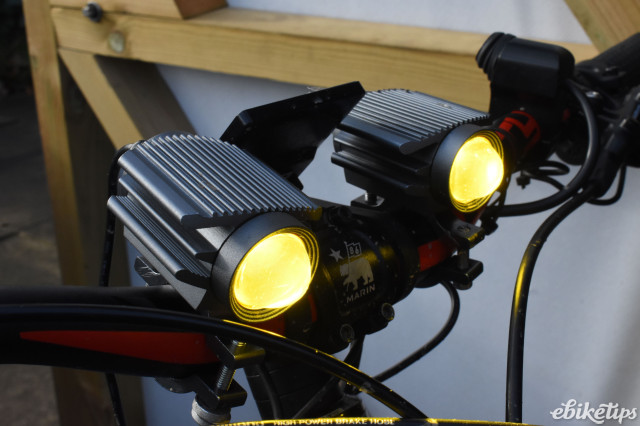
Typically, cheaper conversion kits do not come with lights and the controller on them (where light ports are often found) is not always intended to be accessible to the end user. Some better quality kits like the Cytronex and CYC Photon are however specifically made to have lights easily retrofitted. (The latter comes with yellow-tinted daytime running lights and a pure white high beam setting).
Cytronex supply Busch and Muller lights that plug straight into the Cytronex Boost Button on the handlebar and are switched on an off by holding down the right side of the Boost Button (which also dims the LEDs for night mode to the level set in the app). However, with many other kits, it may simply not be possible to fit lights or it may need some disassembly and some electrical engineering ability to retrofit them.
Budget
As you might expect, ‘be seen’ low power bike lights are out there online for a matter of pence. We’d definitely recommend a recognised brand and those at the reasonable price end of the market include AXA, Decathlon, Oxford Products and Knog. These start at around around £15.

The likes of Cateye, Hermanns, Magicshine and Busch and Muller are a step up in quality and functionality, whilst the the likes of Lupine and Supanova would consider themselves among the creme de la creme of super powerful and multi-functional bike light companies. At the top end, you are talking hundreds of pounds.
One reason for upgrading your lights may be to provide you with more functionality – for example you light want lights with a full-beam option for quiet, unlit roads and tracks, or a rear light with a brake sensor for added safety. There are numerous power levels and many flashing patterns on even moderately-priced lights.
Looking ahead, full indicator lights might be on the horizon (various attempts have come and gone but none have been very good). Busch & Muller appear to have designed such a system, though it is not widely available.
See or be seen? Lumens, watts, lux and candelas…
Bike lights are usually rated in lumens but it’s not uncommon to see them rated in watts too. An approximate conversion from LED watts to lumens is:
4W = 220+ lumens
6W = 400+ lumens
10W = 700+ lumens
13W = 900+ lumens
18W = 1300+ lumens
The above is only a rule of thumb. Watts measure power used by the light, whilst lumens measure what is visible to the human eye. Not all LEDs are the same. Cheap ones may use more power and produce less light. Some lights also spray light all over whereas the focusing tech on better lights tends to put the light where you want it.
As a general guide, front light outputs of 500 lumens and up will allow you to clearly see where you are going on unlit roads and tracks – though that’s not the whole story: lights with ratings in the lower hundreds can still be very effective if the beam itself is concentrated in just the right place. Down at sub-200 lumen level you are definitely at the ‘be seen’ level however, rather than getting any meaningful illuminating power.
The width of the beam is important and most e-bikers find a wide beam more useful for mountain biking (to see all the possible hazards and where the track goes) whilst road riding is more predictable so a powerful slightly more concentrated beam can be more helpful.

You may also see lux and candelas used relating to the light output of bike lights. Broadly speaking, lumen is an overall measure of how much light is emitted, candela indicates the visible intensity in a given direction from the light source, and lux values tell you how much light is falling on a given surface. The latter two are really of most use to those designing the lights and setting standards for them. Potential light buyers are better off finding a light with the right lumen rating for them and looking at its spread pattern (road.cc’s beam comparison engine is useful for comparing standalone bike lights).
If you do happen to come across lights specced in lux then a very rough rule of thumb would be 90 lumens = 40 lux, 650 lumens = 120 lux and 1,100 lumens = 250 lux. This isn’t precise as it depends on exactly where you are measuring the light.
The law in brief
UK law says a white light must be showing from the front of your bike and a red light from the rear only between sunset and sunrise. The front light should be placed centrally or on the offside. Flashing lights are permitted as long as they flash between 60 and 240 times per minute.
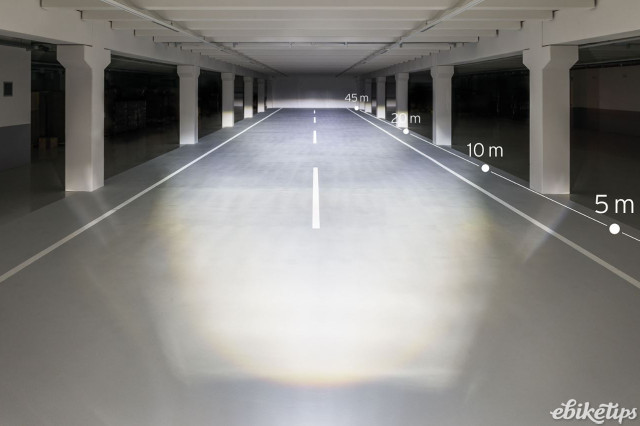
Lastly, is is worth noting which lights are STZVO rated. This is a German legal standard but helps to ensure that super-powerful lights don’t blind oncoming traffic. Notably, 205 lumens is the maximum output for the front light but even lights at this rating can be hugely effective as current reflector and lens technology on e-bike lights has come on leaps and bounds in recent years.
